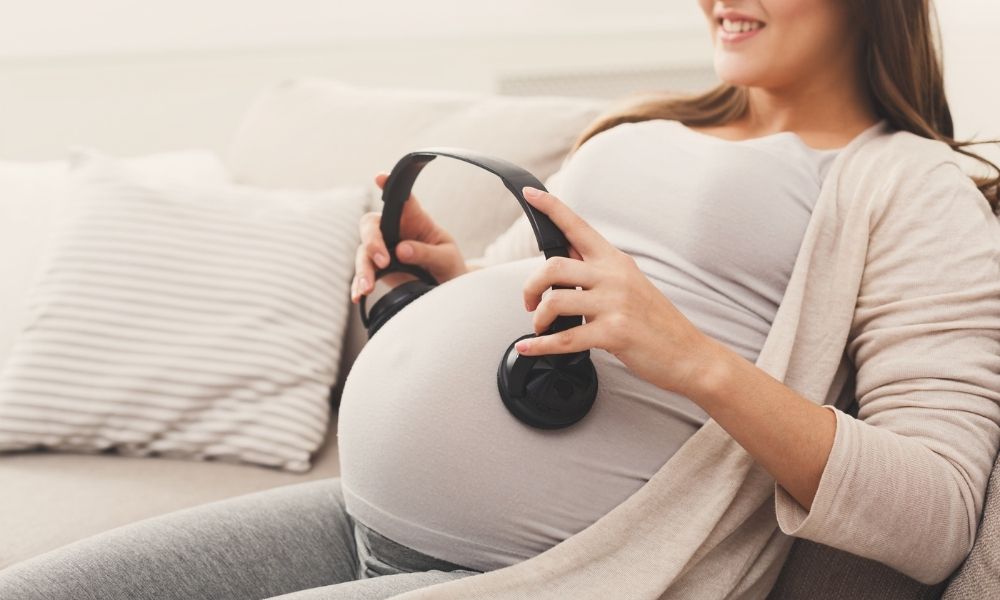In the first trimester of pregnancy many women feel comfortable continuing with the types of exercise they have previously done, whether that be cardio based, yoga, Pilates etc. This is completely safe, however some women find the 1st trimester the most physically demanding and have low energy, or nausea to contend with.
For this reason, some women prefer to reduce the intensity of their workouts or take more frequent rest days. The only main safety consideration I would include here, however, is that it’s not advisable to get too hot during pregnancy, so you may wish to avoid exercise such as Bikram Yoga. It’s also worth letting your doctor or midwife know that you are aiming for an active pregnancy as soon as you can, so they can let you know if you have any absolute contraindications to exercise to be aware of.
By week 14-16 it’s usually uncomfortable to lie on your back or front, and it’s not advisable to lie flat on your back for too long (around 3 mins) as it can lead to something called Supine Hypotensive Disorder. This may mean you use props to help elevate you when in your usual Pilates or Yoga class, or that you switch to a prenatal specific class.
We also want to start thinking about how we train the core in the 2nd trimester. During pregnancy around 100% of us will develop Diastasis Rectus Abdominis – a completely normal and functional separation of our Rectus Abdominis muscle (our 6-pack abs). Therefore, we want to try to allow these natural changes to take place, whilst keeping the core strong. I advise women to turn their attention to their Transversus Abdominis muscle, which acts as a corset around the core, and their pelvic floor. This is a huge part of The Bump Plan training and can really help support a growing bump and prepare the body for the demands of motherhood. Strength-based workouts such as Pilates or weight training can be really beneficial here at ensuring the postural muscles stay active. Cardiovascular-based workouts are still safe for the remainder of pregnancy, but we would advise you work at a moderate intensity for these.
In the 3rd trimester I really start to focus on the muscles that will be needed during labour, and for recovery – no matter how you birth your baby. There should be a large focus on glute engagement, to help support the pelvis as it deals with the weight of a growing uterus, and hip mobility work which can help mobilise the pelvis and allow optimal foetal positioning. There are of course logistical changes that need to be made to workouts now that there is a large bump to contend with, and an emphasis on pelvic floor engagement AND relaxation can be helpful for a vaginal birth, and postnatal recovery. Some women find the breath work, and relaxation work, of yoga or Pilates really welcoming during the 3rd trimester, whereas other women will be happy to continue with more cardiovascular based work.
It really is such an individual choice, as what feels good to one person will be different to another. The most important thing is that you are enjoying what you do, you feel better for doing it (rather than it causing pain or absolute exhaustion) and you consider things like doming (where the pressure in your core pushes through the midline of your bump – a sign you need to regress an exercise) or leaking of urine or faeces (a sign usually that you are overdoing it).
The best pregnancy workouts
Pilates – this is low impact (so ideal if you are struggling with a weak pelvic floor or pelvic girdle pain), has a huge focus on posture (which can change drastically change during pregnancy) and can really help support the core and pelvic floor! It’s almost always advised by Doctors, and even though it is safe, don’t be fooled into thinking it it easy!
Cardiovascular training methods such as running/spinning– personally I believe that a comfortable, functional body comes from having a strong musculoskeletal system (eg strength) and a strong cardiovascular system (eg fitness). Cardiovascular exercise might not always be top of the list when it comes to pregnancy (as you can often feel pooped) but it is so important. Aim for a moderate intensity – this means you could still hold a conversation or are working at around 6/10 on a scale of 1-10. If you continue to run monitor if it causes any leaking, or feelings of heaviness in the vagina (which could suggest a symptom of prolapse)
Flexibility workouts such as yoga – during pregnancy our bodies can feel “tight” and like they want to be stretched out. We need to be a bit careful here though, as it doesn’t necessarily mean we ARE tight. When certain muscles aren’t working effectively, and our joints are more lax (during pregnancy our joints become more mobile due to our hormones), we can find other muscles feel “tight” because they are working overtime to stabilise joints. If we then stretch stretch stretch we become more lax, when stability and strength work is what we actually need. Personally, if I were to practice yoga during pregnancy I would attend a prenatal safe class, that takes into account the changes happening at your joints during pregnancy.
Breathwork classes and meditation – during pregnancy our breathing dynamics change. Our uterus begins to elevate upwards towards the diaphragm (our breathing muscle) making it more challenging to breathe fully. It’s important therefore that we spend some time trying to maintain as best practice as possible. Sitting, concentrating and connecting with the breath can really help with postnatal recovery too.
Swimming – swimming during pregnancy can feel heavenly, as it supports the weight of your bump and takes pressure off your joints. It can also tick both strength and cardio boxes. Some considerations are to aim for moderate intensity, not get too hot (it can be harder to judge internal temperature in a pool) and if you suffer with Pelvic Girdle Pain you may want to avoid breaststroke legs. Otherwise if it feels good, it’s a great low impact option!
All information we provide is for educational and awareness purposes only. Any concerns should be discussed with your GP, Midwife or Healthcare Professional.
If you’re trying to conceive (TTC), you probably know that there are certain foods and nutrients that become especially important once you’re pregnant. But nutrition plays a vital role even when trying to conceive, much like laying a strong foundation before constructing a house.
Certain nutrients create that foundation by supporting egg and sperm health (yes, nutrition matters for both partners), hormone balance and creating a hospitable environment for a fertilized egg to implant. In fact, studies show that certain nutrients can help increase fertility and improve success rates for both natural conception and fertility treatments.
In other words, nutrition is a key player in the TTC journey, but getting the right nutrients in the right quantities can be tricky. That’s where supplements come in. Just as you’d take a multivitamin to fill in nutritional gaps for optimal health, fertility supplements can give you that extra nutrient boost.
Choosing supplements for your fertility journey
When choosing a supplement to support your fertility journey, look for science-backed, high-quality ingredients. Our editors are careful to select and partner with brands that use ingredients that have been clinically studied to support fertility. Eu Natural® (pronounced you) covers all those bases and more. We love knowing that Eu Natural® products contain zero artificial additives, binders, or fillers and are lab-tested to ensure purity and potency.

When choosing a supplement to support your fertility journey, look for science-backed, high-quality ingredients. Our editors are careful to select and partner with brands that use ingredients that have been clinically studied to support fertility. Eu Natural® (pronounced you) covers all those bases and more. We love knowing that Eu Natural® products contain zero artificial additives, binders, or fillers and are lab-tested to ensure purity and potency.





.jpg)

.png)
.jpg)

%20copy.jpg)


